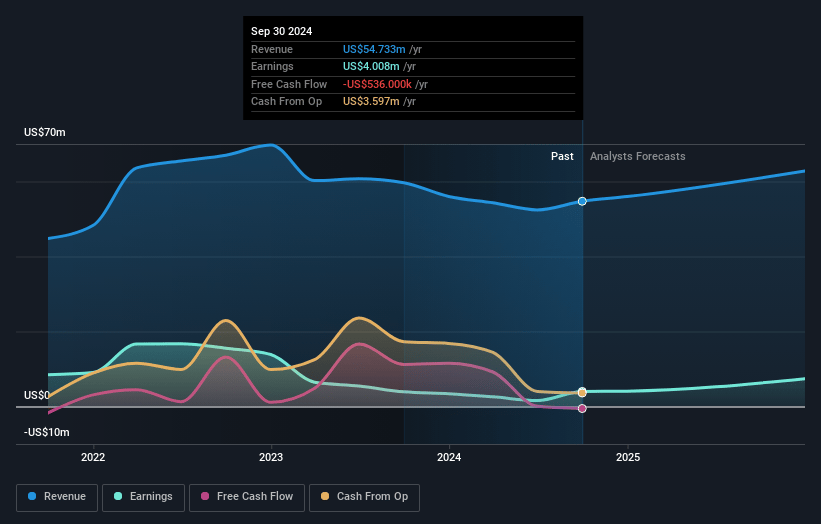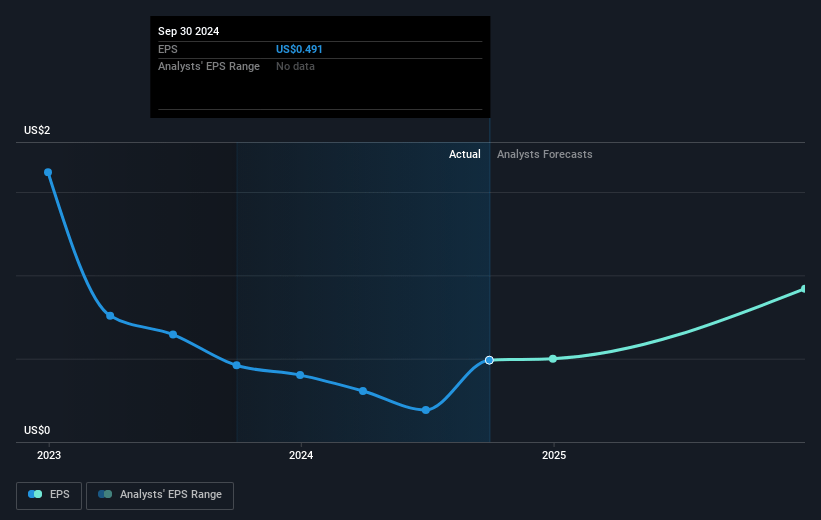Key Takeaways
- Extended agreement with Goldman Sachs bolsters revenue stability and visibility through locked-in payments, enhancing managed services fees.
- Growth in non-Goldman business and new customer onboarding drive significant revenue diversification and stability, supported by the CoreFinity platform's operational efficiencies.
- Reliance on key partnerships, costly platform development, and leadership uncertainties pose risks to CoreCard's financial stability and long-term growth.
Catalysts
About CoreCard- Offers technology solutions and processing services to the financial technology and services market in the United States, Europe, and the Middle East.
- CoreCard's extended agreement with Goldman Sachs provides increased revenue visibility through locked-in payments until at least 2026, bolstering revenue predictability and potentially increasing managed services fees, which will improve revenue stability.
- The growth of non-Goldman business at a projected 30% compound annual growth rate over the next few years is expected to drive significant revenue growth, enhancing revenue diversification.
- Ongoing investments in the new CoreFinity platform, expected to be fully utilized by 2026, can potentially reduce operating costs and increase efficiencies, consequently improving net margins.
- Continued onboarding of new customers and partnerships is anticipated to drive future processing and maintenance revenue growth, which should positively impact overall revenue.
- Share buybacks using excess cash and consistent operating cash flow are expected to limit stock dilution and potentially increase earnings per share through reduced share count.
CoreCard Future Earnings and Revenue Growth
Assumptions
How have these above catalysts been quantified?- Analysts are assuming CoreCard's revenue will grow by 11.4% annually over the next 3 years.
- Analysts assume that profit margins will increase from 7.3% today to 21.1% in 3 years time.
- Analysts expect earnings to reach $16.0 million (and earnings per share of $2.01) by about December 2027, up from $4.0 million today. The analysts are largely in agreement about this estimate.
- In order for the above numbers to justify the analysts price target, the company would need to trade at a PE ratio of 8.6x on those 2027 earnings, down from 45.0x today. This future PE is lower than the current PE for the US Software industry at 43.0x.
- Analysts expect the number of shares outstanding to grow by 0.17% per year for the next 3 years.
- To value all of this in today's terms, we will use a discount rate of 6.98%, as per the Simply Wall St company report.
CoreCard Future Earnings Per Share Growth
Risks
What could happen that would invalidate this narrative?- The potential loss of the Apple Card program to another bank poses a significant risk, which could lead to a substantial decrease in revenue and long-term growth as CoreCard relies heavily on this relationship.
- The need for costly continuous investment in the development of the new CoreFinity platform highlights financial commitment risks that might not immediately yield returns, impacting net margins and cash flow.
- Auditor change due to cost concerns introduces uncertainty and may raise questions about financial reporting reliability, potentially affecting investor confidence and future earnings stability.
- Concentrated revenue dependency on Goldman Sachs poses a risk as it dominates CoreCard's business; any shifts in this relationship or performance issues could severely impact revenue and overall financial health.
- Succession planning uncertainties raise concerns about leadership continuity and strategic direction, which could destabilize company operations and affect long-term earnings potential.
Valuation
How have all the factors above been brought together to estimate a fair value?- The analysts have a consensus price target of $16.0 for CoreCard based on their expectations of its future earnings growth, profit margins and other risk factors.
- In order for you to agree with the analyst's consensus, you'd need to believe that by 2027, revenues will be $75.7 million, earnings will come to $16.0 million, and it would be trading on a PE ratio of 8.6x, assuming you use a discount rate of 7.0%.
- Given the current share price of $22.83, the analyst's price target of $16.0 is 42.7% lower. Despite analysts expecting the underlying buisness to improve, they seem to believe the market's expectations are too high.
- We always encourage you to reach your own conclusions though. So sense check these analyst numbers against your own assumptions and expectations based on your understanding of the business and what you believe is probable.
How well do narratives help inform your perspective?
Disclaimer
Warren A.I. is a tool utilizing a Large Language Model (LLM) that ingests data on consensus price targets, forecasted revenue and earnings figures, as well as the transcripts of earnings calls to produce qualitative analysis. The narratives produced by Warren A.I. are general in nature and are based solely on analyst data and publicly-available material published by the respective companies. These scenarios are not indicative of the company's future performance and are exploratory in nature. Simply Wall St has no position in the company(s) mentioned. Simply Wall St may provide the securities issuer or related entities with website advertising services for a fee, on an arm's length basis. These relationships have no impact on the way we conduct our business, the content we host, or how our content is served to users. The price targets and estimates used are consensus data, and do not constitute a recommendation to buy or sell any stock, and they do not take account of your objectives, or your financial situation. Note that Warren A.I.'s analysis may not factor in the latest price-sensitive company announcements or qualitative material.




